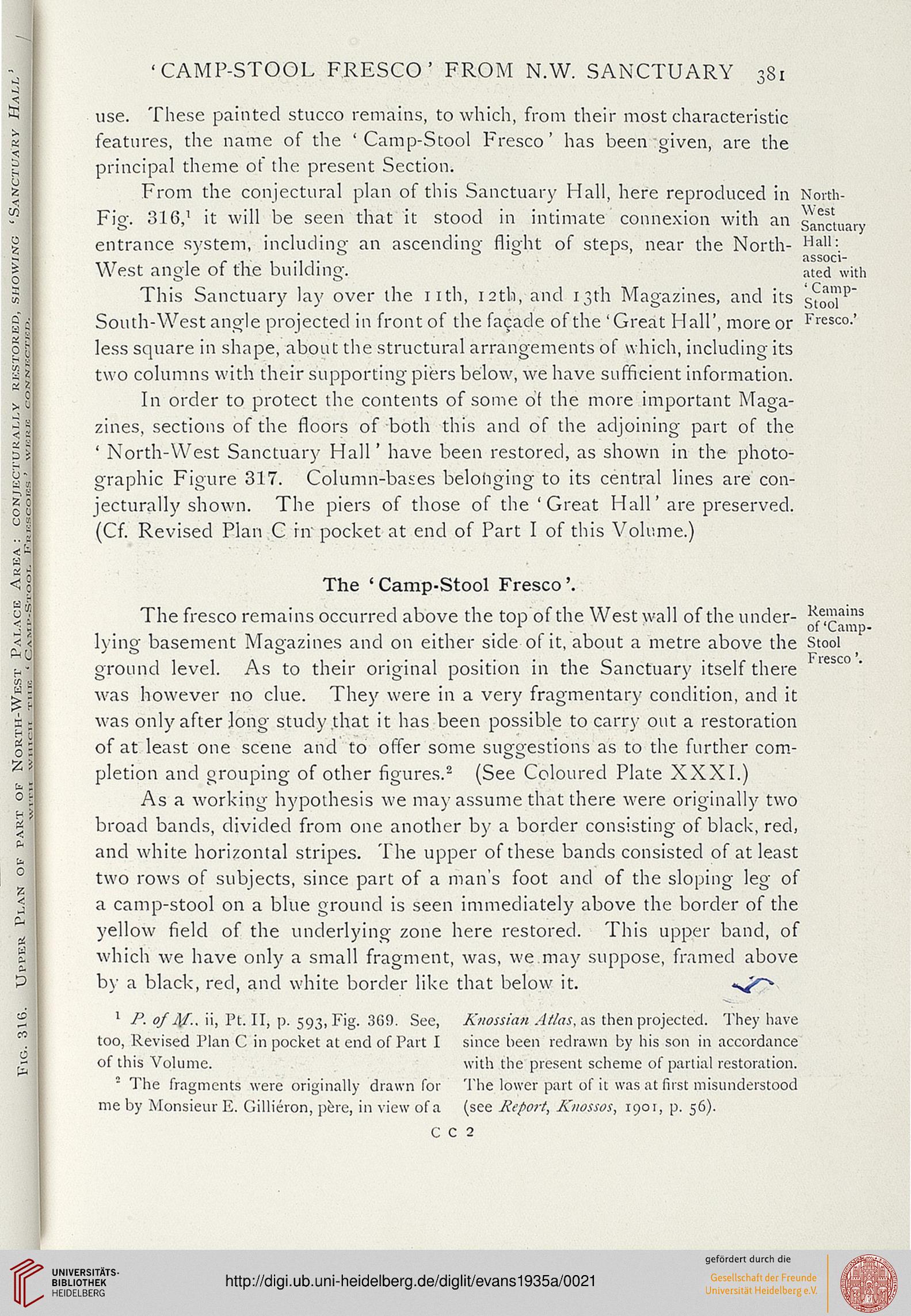'CAMP-STOOL FRESCO' FROM N.W. SANCTUARY 381
use. These painted stucco remains, to which, from their most characteristic
features, the name of the ' Camp-Stool Fresco ' has been given, are the
principal theme of the present Section.
From the conjectural plan of this Sanctuary Hall, here reproduced in North-
Fig. 316,' it will be seen that it stood in intimate connexion with an sanctuary
entrance system, including an ascending flight of steps, near the North- Hall:
ilSSOCl-
West angle of the building. ated with
This Sanctuary lay over the nth, 12th, and 13th Magazines, and its stool
South-West angle projected in front of the facade of the ' Great Hall', more or Fresco.'
less square in shape, about the structural arrangements of which, including its
two columns with their supporting piers below, we have sufficient information.
In order to protect the contents of some of the more important Maga-
zines, sections of the floors of both this and of the adjoining part of the
' North-West Sanctuary Hall' have been restored, as shown in the photo-
graphic Figure 317. Column-bases belonging to its central lines are con-
jecturally shown. The piers of those of the 'Great Hall'are preserved.
(Cf. Revised Plan C in' pocket at end of Part I of this Volume.)
The 'Camp-Stool Fresco'.
The fresco remains occurred above the top of the West wall of the under- Remams
1 ot Lamp-
lyillg basement Magazines and on either side of it, about a metre above the Stool
ground level. As to their original position in the Sanctuary itself there
was however no clue. They were in a very fragmentary condition, and it
was only after Jong study .that it has been possible to carry out a restoration
of at least one scene and to offer some suggestions as to the further com-
pletion and grouping of other figures.2 (See Coloured Plate XXXI.)
As a working hypothesis we may assume that there were originally two
broad bands, divided from one another by a border consisting of black, red,
and white horizontal stripes. The upper of these bands consisted of at least
two rows of subjects, since part of a man's foot and of the sloping leg of
a camp-stool on a blue ground is seen immediately above the border of the
yellow field of the underlying zone here restored. This upper band, of
which we have only a small fragment, was, we may suppose, framed above
by a black, red, and white border like that below it.
1 P. o/Jg.. ii, Pt'.IIj p. 593, Fig. 369. See, Knossiaii:Ailas, as then projected. They have
too, Revised Plan C in pocket at end of Part I since been redrawn by his son in accordance
of this Volume. with the present scheme of partial restoration.
2 The fragments were originally drawn for The lower part of it was at first misunderstood
me by Monsieur E. Gillieron, pere, in view of a (see Report, Knossos, 1901, p. 56).
use. These painted stucco remains, to which, from their most characteristic
features, the name of the ' Camp-Stool Fresco ' has been given, are the
principal theme of the present Section.
From the conjectural plan of this Sanctuary Hall, here reproduced in North-
Fig. 316,' it will be seen that it stood in intimate connexion with an sanctuary
entrance system, including an ascending flight of steps, near the North- Hall:
ilSSOCl-
West angle of the building. ated with
This Sanctuary lay over the nth, 12th, and 13th Magazines, and its stool
South-West angle projected in front of the facade of the ' Great Hall', more or Fresco.'
less square in shape, about the structural arrangements of which, including its
two columns with their supporting piers below, we have sufficient information.
In order to protect the contents of some of the more important Maga-
zines, sections of the floors of both this and of the adjoining part of the
' North-West Sanctuary Hall' have been restored, as shown in the photo-
graphic Figure 317. Column-bases belonging to its central lines are con-
jecturally shown. The piers of those of the 'Great Hall'are preserved.
(Cf. Revised Plan C in' pocket at end of Part I of this Volume.)
The 'Camp-Stool Fresco'.
The fresco remains occurred above the top of the West wall of the under- Remams
1 ot Lamp-
lyillg basement Magazines and on either side of it, about a metre above the Stool
ground level. As to their original position in the Sanctuary itself there
was however no clue. They were in a very fragmentary condition, and it
was only after Jong study .that it has been possible to carry out a restoration
of at least one scene and to offer some suggestions as to the further com-
pletion and grouping of other figures.2 (See Coloured Plate XXXI.)
As a working hypothesis we may assume that there were originally two
broad bands, divided from one another by a border consisting of black, red,
and white horizontal stripes. The upper of these bands consisted of at least
two rows of subjects, since part of a man's foot and of the sloping leg of
a camp-stool on a blue ground is seen immediately above the border of the
yellow field of the underlying zone here restored. This upper band, of
which we have only a small fragment, was, we may suppose, framed above
by a black, red, and white border like that below it.
1 P. o/Jg.. ii, Pt'.IIj p. 593, Fig. 369. See, Knossiaii:Ailas, as then projected. They have
too, Revised Plan C in pocket at end of Part I since been redrawn by his son in accordance
of this Volume. with the present scheme of partial restoration.
2 The fragments were originally drawn for The lower part of it was at first misunderstood
me by Monsieur E. Gillieron, pere, in view of a (see Report, Knossos, 1901, p. 56).




